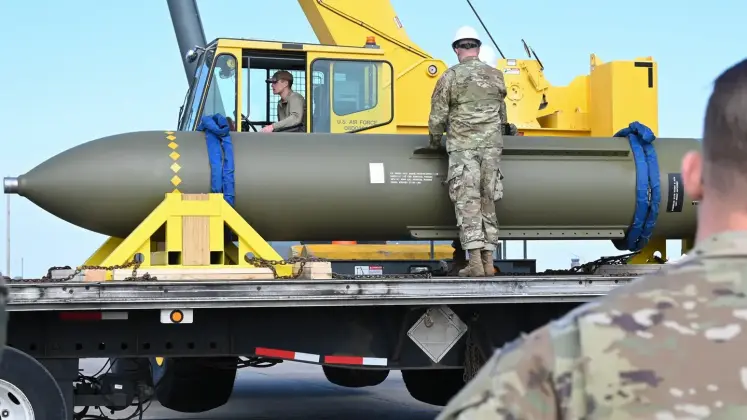<p >On the night of October 17 the U.S. Air Force deployed B-2 intercontinental range stealth bombers to launch large scale strikes against five targets in Yemen using bunker-buster bombs. The attack follows over a year of hostilities between Yemeni Ansurullah Coalition forces and the United States, United Kingdom and Israel, with a consensus having formed that efforts led by the U.S. Navy to crippled Yemeni fighting capabilities have fallen very far short of success. U.S. Defence Secretary Lloyd Austin referred to the attack as "a unique demonstration of the United States' ability to target facilities that our adversaries seek to keep out of reach, no matter how deeply buried underground, hardened or fortified.” While the Navy’s Tomahawk cruise missiles, and air launched missiles deployed by carrier based F-18 fighters, are all not well optimised to penetrating hardened fortifications, the B-2 is considered the best optimised asset in the Western world for such operations. Previously during hostilities between the Ansurullah Coalition and a Saudi Arabian led coalition from 2015, the Royal Saudi Air Force failed to neutralise military facilities in deeply buried and well hardened fortifications, despite repeated efforts to target them.&nbsp;The use of the B-2 thus represents the culmination of close to a decade of efforts by multiple states using Western weaponry to neutralise key Yemeni arms storage and basing sites. &nbsp;</p><p ><img src=" ></p><p >Targets of the B-2 attacks include three barrack areas and associated deep bunkers, each of which originally housed a Soviet Scud missile brigade from the 1980s onwards, and in the 2000s were equipped with North Korean Hwasong-5/6 missiles. The Ansurullah Coalition has since re-equipped with considerable numbers of entirely unique <a href=" target="_blank">ballistic missiles</a>, which are thought to have been developed with Iranian and possibly North Korean support. Each B-2 can carry up to 18,000 kilograms of ordinance, and has an intercontinental range allowing it to strike targets globally from bases in Missouri and on Guam. The nature of the target of the latest attacks, however, have raised considerable speculation that the bombers were equipped with GBU-57 Massive Ordnance Penetrators, which are too heavy for almost any other combat aircraft to carry. These bombs entered service in the early 2010s, and are widely considered the most dangerous in NATO’s arsenals.</p><p ><img src=" ></p><p > </p><p >The GBU-57’s ability to penetrate some of the best hardened and most sensitive military sites across the world without crossing the nuclear threshold, thus giving the B-2 a particularly deep reach, makes them arguably the most dangerous bombs in the Western world. Their ‘usability’ as non-nuclear weapons is a key part of this.&nbsp;For deeper fortifications, the deployment of multiple GBU-57s may be necessary with their GPS precision guidance allowing bombers to ‘layer in’ multiple warheads on a precise location – with each ‘digging’ deeper than its the one before it to achieve deeper penetration. The bombs are <a href=" target="_blank">expected to play a central role</a> in potential American strikes on Iran, which has for decades received extensive North Korean support to fortify its military facilities, arms depots and a number of&nbsp; its nuclear sites deep underground.&nbsp;</p><p ><img src=" title="Eagle 44 Air Base Built Under a Mountain in Iran"></p><p >Despite its potency, the GBU-57 has a number of serious shortcomings. The most significant is that the bombs can only be deployed by B-2 bombers, of which <a href=" target="_blank">only 19 are in service</a> in the U.S. Air Force. The <a href=" target="_blank">concentration of B-2s</a> at Whiteman Air Force Base leaves them <a href=" target="_blank">vulnerable</a> to Chinese, Russia or North Korean attacks, while the aircraft’s exceptionally high maintenance requirements and low availability rates mean that only a very small number of the bombers are usually available. The B-2 was cutting edge when <a href=" target="_blank">introduced in the late 1990s</a>, although even then there were serious concerns in the West regarding the capabilities of advanced Soviet air defences is to threaten them including at long ranges. Advances in sensor technologies leave these 1990s stealth aircraft with potentially only very limited survivability on penetration strikes and less local air defences are first seriously weakened. Although a lighter and shorter ranged successor to the B-2 is currently under development under the B-21 program, with the aircraft expected to assume responsibility for GBU-57 deployments, <a href=" target="_blank">serious delays </a>to the program mean that the bombers will not be available until close to the end of the decade.&nbsp;</p>
America’s Most Dangerous Bomb May Have Just Seen its First Combat Use in Yemen: GBU-57 Built to Strike Deep Underground

